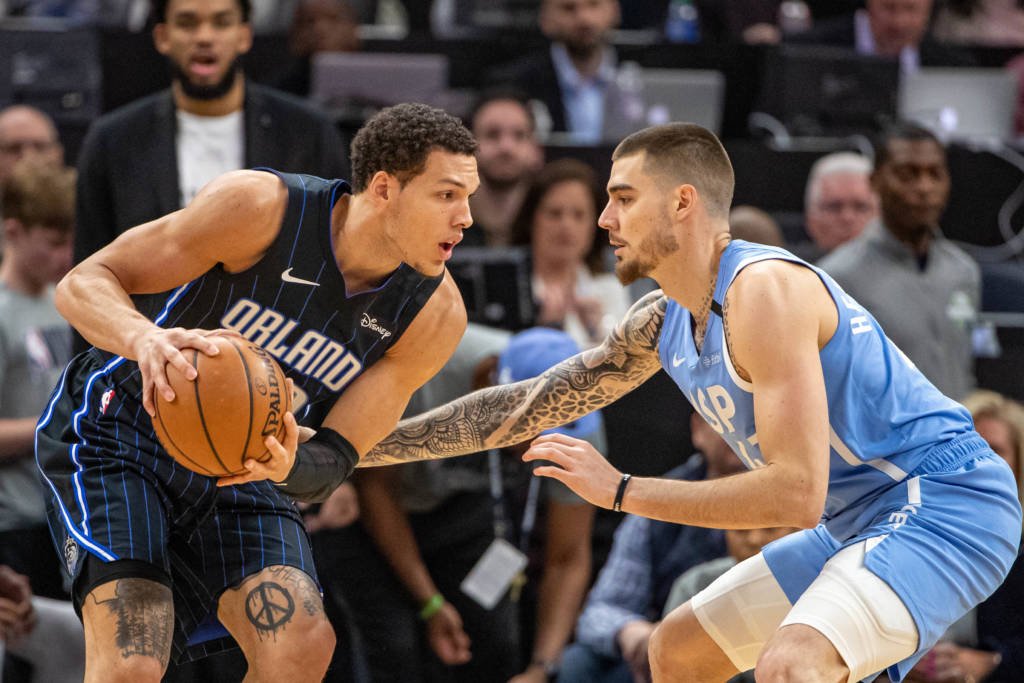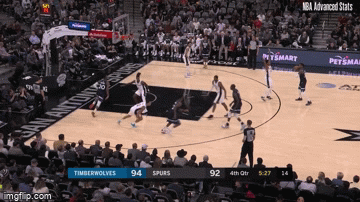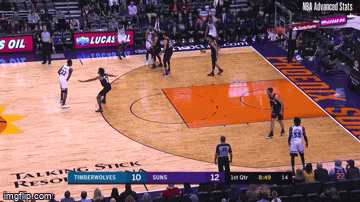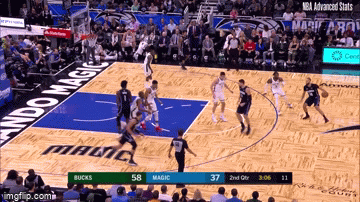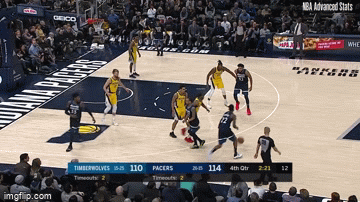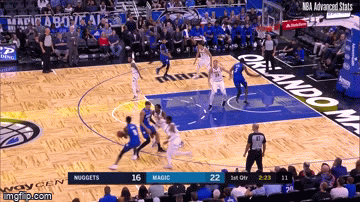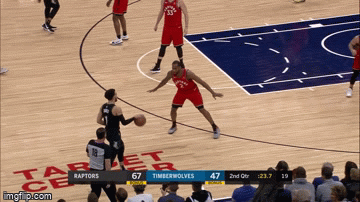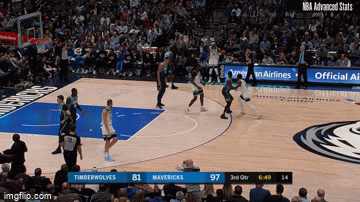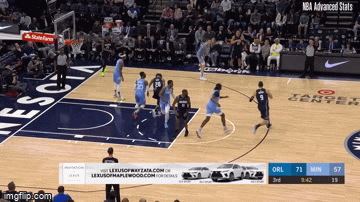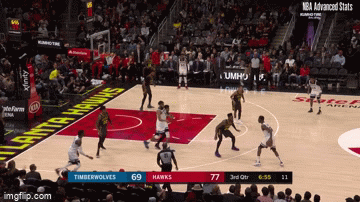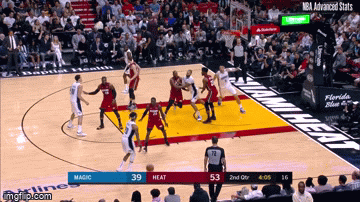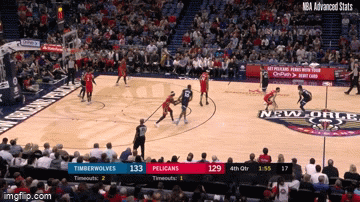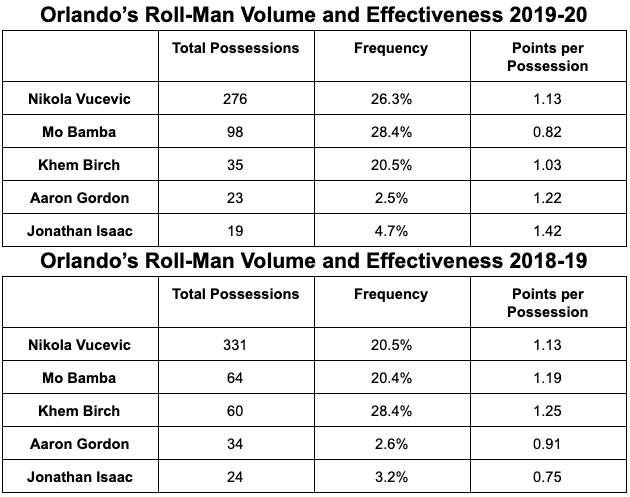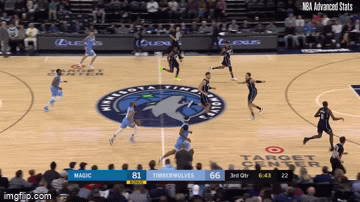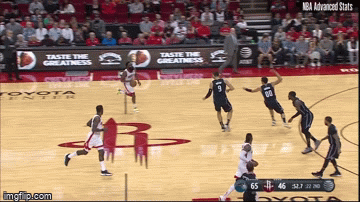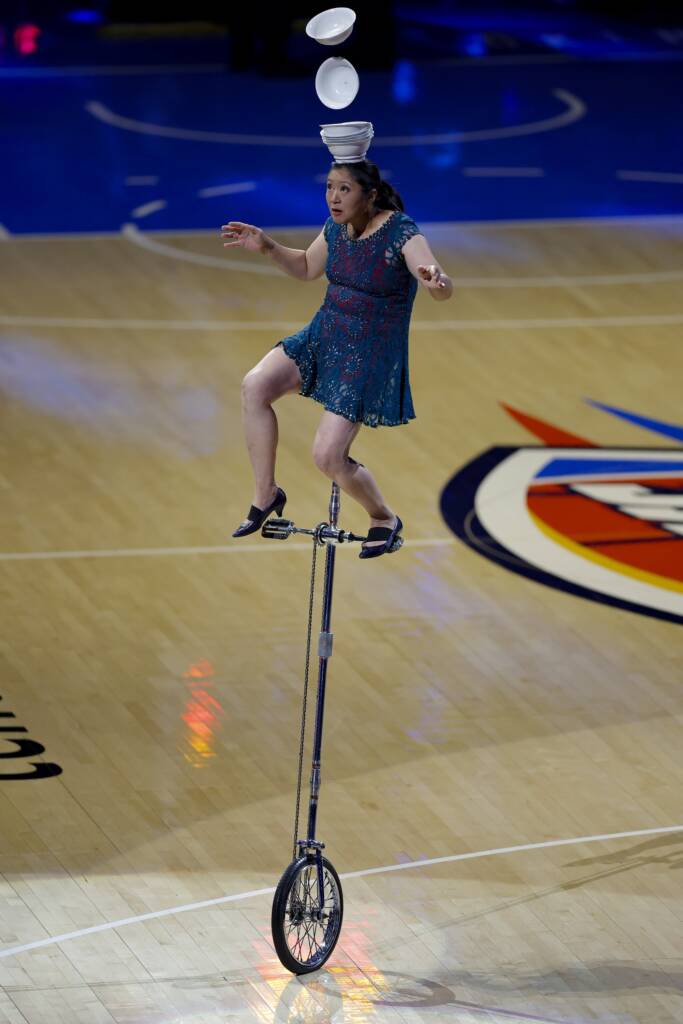Looking into what type of player could become Karl-Anthony Towns‘ long-term frontcourt partner can be done two different ways: 1) Through the lens of how we have traditionally come to understand roster construction; 2) Through the lens of how Gersson Rosas has been constructing the Minnesota Timberwolves roster since he took over the franchise.
As this connects to the power forward position, the traditional lens would find logic in its namesake — by finding a traditional power forward.
This line of thinking leans on the fact that the Timberwolves have ranked 25th or worse defensively in every season of Towns’ career, and pushes a theory that a bigger, more defensive-minded player next to the center would help mitigate the bruising that has taken place. In other words, acquiring a traditional power forward would be a ploy that counters bruising with brute force.
The Rosas lens is different — finding logic through system fit.
The pattern of Rosas’ roster construction behavior suggests that he prefers to find a group of players that weave themselves together to mend gaps rather than applying individual patches over rips in the fabric. Grabbing a traditional power forward who was not a system fit simply to address a hole would not be what we have come to understand Rosas’ style to be.
While many Timberwolves followers ache for a tall, bona fide rim-defender next to Towns, that desire is purely aspirational. If Rosas’ is to stick to his pattern, that just ain’t happening.
This patterning began on Draft Night 2019 when Rosas traded incumbent starting power forward Dario Saric to move up in the draft to acquire a player he felt was a better fit in the system (Jarrett Culver). A career 36 percent shooter from deep, Saric did fit some of Rosas’ desired mold. But Saric’s physical shortcomings, which limited his ability to play with pace, made him a piece Rosas deemed expendable.
In a similar vein, Gorgui Dieng, who made 38 percent of his 3s in Minnesota this season, was also moved at the trade deadline — not because he couldn’t space the floor around Towns but because he couldn’t run it with him. Dieng and Towns only shared the floor for eight of Towns’ 1,187 minutes this season.
Saric’s departure instigated an upward position shift for Robert Covington. In many ways, Covington was a theoretically-sound fit next to Towns. But Covington was also traded by Rosas. There were numerous motivations behind that trade. A primary motivator was Covington being a valuable asset that could easily be liquidated. For example, one of the two first-round picks acquired for Covington was rerouted to Denver in exchange for Malik Beasley and Juancho Hernangomez.
Outside of the asset value, that trade was also motivated by the notion that Covington was not an ideal system fit. His age — 30 next season — didn’t fit the mold. Additionally, while Covington was a stronger individual defender, his defensive partnership with Towns in the Wolves’ defensive scheme was not effective. In the 747 minutes Covington and Towns shared the floor this season, the Wolves surrendered 117.0 points per 100 possessions — Towns’ worst defensive pairing of any player he shared the floor with for substantial minutes this season.
You’ll notice that none of the above players are, well, tall, so in the trading of Covington, Hernangomez naturally became Rosas’ power forward replacement. In a far bigger role than he had in Denver, Hernangomez showcased the outlining of a player who fit the system. Namely, his 42 percent shooting from deep and ability to play with pace were two positives immediately recognized.
But Hernangomez’s physical shortcomings also became apparent in the 14 games he played for the Wolves, diminishing some of the belief that he could be a true starting fit next to Towns. Physically, Hernangomez was frequently overpowered on the interior defensively and also struggled to finish through defenders around the rim on offense.
There is reason to believe that Rosas is pleased with a lot of what he’s seen from Hernangomez since the trade deadline. But there is also reason to believe that Rosas may prefer that type of player in a bench role. It would make sense for a higher performance bar to be set for the starting power forward.
So again, the question remains what does that power forward look like? Maybe bits and pieces of Covington mixed with bits and pieces of Hernangomez? I’d add another wrinkle to that mix: pieces of Jordan Bell.
While Dieng was only permitted to share the floor with Towns for eight minutes this season, and Noah Vonleh for 25, Bell flanked Towns for 102 minutes (the vast majority of Bell’s non-garbage time). While Bell cannot shoot — he made his first 3 of his career this season — he does bring defensive versatility in addition to the ability to play with pace and chops as a fluid roll-man in the pick and roll. For his many shortcomings, Bell may have been the ideal physical archetype of power forward to partner with Towns.
Maybe then a blend of Covington, Hernangomez and Bell’s attributes shape a more holistic outline of Rosas’ preferred power forward. Scouring the league for that type of player is a tall task. Not many fit the mold. In my purview, I would argue that Aaron Gordon of the Orlando Magic is one who does.
How Would Gordon Fit in the Timberwolves System?
Before the trade deadline, when Rosas was looking to reconfigure his roster, it was reported that Minnesota called Orlando about Gordon’s availability. How far those talks went is unknown. Rosas was extremely proactive at the deadline, so that call should be taken with a grain of salt.
Speculatively though, this interest in Gordon was founded in not only the notion that he could be a potential archetypal fit in Minnesota but also from the idea that Gordon doesn’t really fit in Steve Clifford’s system. Rosas’ call may have been knocking on a door that Gordon already has one foot out of.
Since Clifford took over in Orlando two seasons ago, Gordon has played 40 percent of his minutes at small forward, according to Cleaning The Glass’ tracking data. With Orlando heavily-invested in Nikola Vucevic and Jonathan Isaac, necessity forced the invention of sliding Gordon into more of a wing role.
Additionally, Mo Bamba and Khem Birch — two very traditional bigs — have been in the Orlando rotation, making Gordon one of five players splitting minutes in the frontcourt. Statistically, this logjam appears to have wrecked Gordon’s efficiency. When Gordon has played small forward this season, the Orlando offense scored 10 fewer points per 100 possessions than when he played power forward.
This frontcourt logjam would not be a problem if Gordon played in a system like Minnesota’s; a system that wouldn’t dare to even roster five traditional bigs. Houston may be the capital of small-ball USA, but Rosas has been colonizing up north. A player like Gordon would exclusively play power forward next to Towns on the Wolves, and may get some run as a small-ball center. Just as we know that Gordon has been suffocated by a lack of space in Orlando, we know that playing without space is not an option in Minnesota.
It’s easy to connect some dots that would suggest that Gordon could be a far more effective player in Minnesota. Andrew Wiggins’ 2019-20 season is the bread crumb to follow here.

Gordon in the Andrew Wiggins Role
To add a fourth ingredient to the Covington-Hernangomez-Bell cocktail, tenets of Wiggins’ game would also be a welcome addition to the power forward archetype mix. While Gordon might have received too much exposure on the wing in Orlando, the experience he has gained in that role, with some tweaks, could help create a balance that would allow Gordon to approximate much of what Wiggins was asked to do in Minnesota.
If everything fell in line, Gordon’s abilities could maximize that Wiggins role.
Really, Wiggins and Gordon are fairly similar players in a number of ways. If you remove the film of Wiggins running the point and of Gordon in post-ups, what is left over has plenty of parallels.
When Wiggins was not asked to instigate offensive possessions at the point this season, he often started in the corner, raising up once the ball moved to his side of the floor. In these actions, Wiggins would be tasked with finding a seam to exploit.
Similarly, when Gordon was not being tasked with posting up in Orlando, he functioned similarly — rising from the corner, also asked to seek out seams.
The difference between the two players’ games is not so much in skillset as it is in utility. For Wiggins, that utilization took on a massive shift this season — moving away from the midrange and towards the rim or back beyond the arc.
Functionally, Wiggins cut the frequency in which he shot from mid-range in half this season. That missing piece of the pie was redistributed evenly between shots that came in the lane and from beyond the arc. This redistribution helped Wiggins’ effective field goal percentage increase from 46.1 percent in 2018-19 to 50.2 percent in 2019-20 (while he was in Minnesota).
Additionally, an increased willingness to attack the rim boosted the frequency with which Wiggins was getting to the line — creating another jump, this time in his true-shooting percentage (a shooting efficiency stat that also includes free throw percentage).
The idea that Gordon’s game is simply being held back by Clifford in Orlando is wrong.
Gordon’s individual decision-making has played a role in him having had the most disappointing offensive season of his career — including 30.1 percent shooting from deep and 25.4 percent from the mid-range. If possible, those numbers are more concerning in their volume than they are in their effectiveness. This, glass half full, suggests there is room for efficiency growth in Gordon’s game even if the spot-to-spot shot effectiveness does not improve.
Wiggins’ shift in shot selection was not only more efficient because he was taking “better” shots but also ticked up because the Minnesota offense is specifically designed to create looks at the rim and from beyond the arc. Theoretically, Gordon would be able to reap the same benefits of playing in a four- or five-out system.
The biggest statistical uptick Wiggins saw this season was a nearly 10 percent increase in his field goal percentage within the restricted area (up from 58.3 percent to 67.6 percent). He recognized this improvement by taking advantage of the added spacing within the system. Note on this play not only the spacing around Wiggins’ drive but also Saric’s (understandable) unwillingness to leave Towns to provide help.
Gordon experienced anything but elite spacing in Orlando. Frequently playing with two other bigs who prioritized applying pressure on the rim rather than spacing the floor congested the lane for Gordon in his drives to the bucket. This often forced Gordon to need to finish through multiple defenders on his attacks. Note on this play how late (and ineffectively) Vucevic and Isaac attempt to create space on Gordon’s drive.
Still, Gordon was equally effective to Wiggins within the restricted area (67.1 percent versus 67.6 percent). This happened because Gordon is a far more forceful driver than Wiggins is. That’s no slight on Wiggins, it’s just that this force Gordon can apply is his (perhaps only) elite skill.
I would also contend that there is room for development in Gordon’s at the basket game. Highlighted by his poor effectiveness in floater range (35.3 percent shooting), we can see that there is plenty of room for growth when attacking. When Gordon is going to the bucket and faces adversity, he often does one of two hurtful things: (1) take an additional dribble into a fading jump shot; (2) barrel to the rim out of control.
To use a former Timberwolf example, these attacks of the basket that late in the action pivot into east-west movement are reminiscent of Ricky Rubio drives. Rubio was not physical enough to impose his will at the rim, necessitating last-second lateral movements in an effort to evade defenders.
The maddening part of Gordon’s at-the-basket game is that he is physically imposing.
In going through and watching Gordon’s drives, his lateral fading seems to be borne out of scarring from being blocked as many times as he has in his career.
Again, this is a bit bizarre because Gordon is strong and athletic.
To my eye, this is not an indictment of Gordon’s skill set but of his decision-making. He too often ignores the fact that there is not space to drive — and as a result, frequently gets blocked. This has the compounding negative effect of pursuing east-west, Rubio-esque fading jumpers on his drives. Bottom of the line, Gordon could make better decisions with the ball in his hands. But in a system that provides more space (like Minnesota’s), the opportunity to make those bad decisions would decrease.
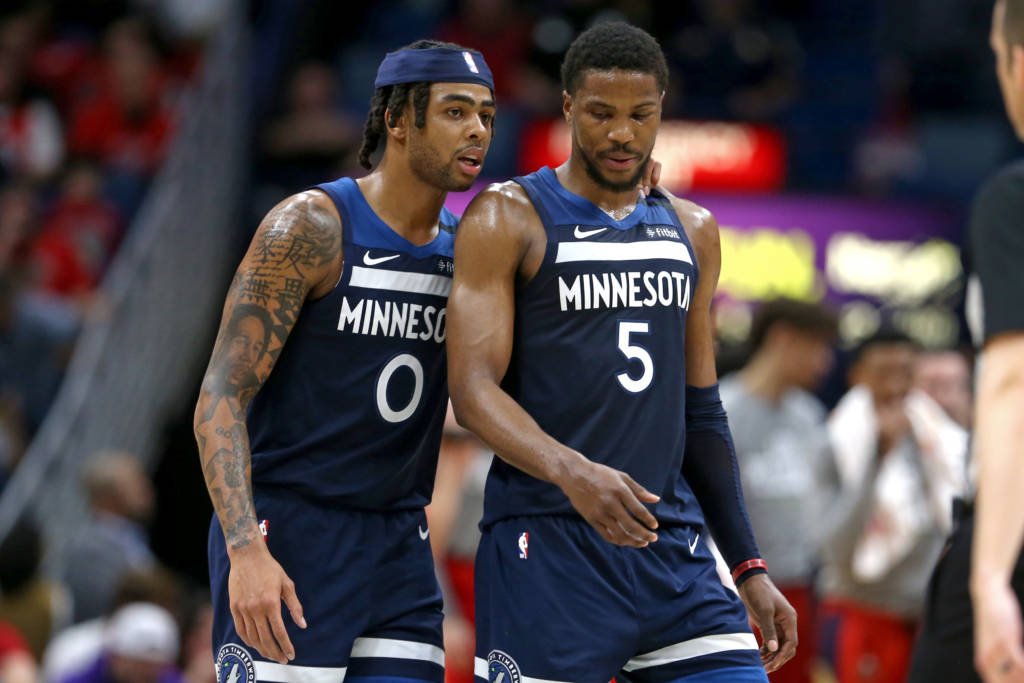
No Longer a Need for a Mid-Range Creator
The key difference between what Wiggins was in Minnesota and what a player like Gordon could be in Minnesota is that this Timberwolves roster no longer needs any additional mid-range shooting.
Before D’Angelo Russell and Beasley — two competent mid-range shooters — were acquired, the Wolves were so thin on creators that Wiggins often had to be the break-glass-in-case-of-emergency guy. If the initial action broke down, Wiggins was tasked with being the late-shot clock bailout option — frequently being forced into a contested mid-range shot.
Gordon often held that desperation shooter role in Orlando, as well. With seven-or-fewer seconds left on the shot clock, Gordon has taken 137 of his 726 shots this season — making 34.9 percent of those looks from 2-point range and 20.4 percent from 3. This is another example of Gordon being used in an outsized role in Orlando that crushes his efficiency. With the abilities Russell, Beasley and Towns have to create looks for themselves, they don’t need their power forward of the future to be a self-creator.
If Gordon wasn’t asked to take these shots, he could work to remove them as habits. But they definitely are habits that need to be broken.
When Gordon chooses to pursue a mid-range shot or when the Orlando offense demands he take it, Gordon’s best tool — his force — is nullified. Again, Clifford’s offense often asks Gordon to raise up from the corner and pursue isolation from the top of the key. More often than not, though, defenses can handle this type of basic offensive action. When defenses did maintain their defensive shell, Gordon, foolishly, was not deterred by the shell.
Instead of passing, he would just pull up.
When Gordon deemed in his head that a play was a scoring situation, by all hell he was going to try and score. That needs to be worked out for Gordon to become an effective player. Gordon has only made 25.4 percent of his 126 looks from the mid-range range this season. That’s the equivalent value of a 17 percent 3-point look.
Again, compare this to Wiggins this season in similar actions. Instead of stalling out at the free throw line, Wiggins would often decide to shift gears into attack mode. With coaching, Gordon could do this, too.
Worse, at times Gordon seems to crave these looks, fleeing the option of attacking the rim and running over to what he thinks is his happy place: the mid-range.
That is another old habit of Wiggins’ that was largely coached out this season. Here’s Wiggins in 2018-19 channeling modern-day Gordon.
These decision-making errors are on Gordon. But that he is continually permitted to pursue those looks is on the coaching staff in Orlando. The flaw is compounded by Clifford having run specific sets that are designed to generate looks for Gordon from these areas. This is an out of bounds set crafted with the specific goal of creating a 19-foot jumper for Gordon.
Why?
This could be coached out by, well, not calling those plays.
There is plenty to question about the functionality of Minnesota’s new offensive scheme, but the one thing that can be said with confidence is that a player of Gordon’s ilk being asked to pursue these types of looks would not happen. Ironically, Gordon has made exactly 28.4 percent of both his pull-up 2s and pull-up 3s this season, according to Second Spectrum. To make matters worse, Gordon’s pull-up 2 volume (141 attempts) has more than doubled his pull-up 3 volume (67) this season. That would not fly in Minnesota.
The Need for a Slasher
Instead, what this Minnesota roster craves is a player who can play in a tertiary role. At the power forward position, that would look like an elite cutter. This is not only a skill Gordon possesses, but it’s also one he has experience using in Orlando.
In the Minnesota offense, cutters are going to be needed off Russell at the point. Since the deadline, we’ve seen some of that through a growing synergy for Russell with Jake Layman.
With more force and athletic ability, Gordon could function like a souped-up Layman.
The Minnesota offense also craves cutters off of Towns post-ups — particularly when a double team comes.
A player like Gordon has the skill set to be able to thrive here as well. Gordon specifically has substantial experience in that role having played off of Vucevic for the entirety of his career.
For one reason or another, Gordon has been used in Orlando almost exclusively as on an off-ball cutter. Very rarely does Gordon set on-ball screens. This would present another opportunity for growth in the Minnesota system for Gordon. He could be used as a pick-and-roll partner for Russell much like James Johnson has been utilized since the deadline.
That type of action should only be more powerful with Gordon in Johnson’s place given Gordon’s physical gifts.
The problem here, again, is that Gordon does not have much experience functioning as a roll man. According to Synergy, Gordon has only been used in these roll actions 23 times all season. Clifford has prioritized using Vucevic in these situations. Vucevic has been used as the roll man on 276 pick-and-rolls this season for Orlando.
The fond idea that Gordon could be a Draymond Green-type of player is, in part, founded from the idea that he could mirror what Green has been able to do as a roll man in Golden State. We don’t know if that would work, but we do know Gordon has never really gotten the chance to try it.
In the Minnesota system, any power forward will be pushed to become a high-volume roll man. And in that spot, this Wolves’ roster craves a true rim-roller. Towns is a dynamic pick-and-pop option but has never showcased a high-flying rolling element to his game. In glimpses, we’ve seen that from Gordon.
Playing with pace is also an extension of maximizing cutters.
Functionally, a cut in the halfcourt — whether it be off-ball or in a pick-and-roll — is used to take advantage of a shifting defense. Pushing the pace forces defenses to swiftly shift in transition defense. Having a player like Gordon running with Russell or Beasley would help to maximize the creases in opponent’s transition defense.
Orlando has been one of the slowest teams in the league over the past two seasons (24th in pace in 2018-19 and 26th in 2019-20). This is another stylistic priority that limits a player like Gordon — who theoretically has the skill set to thrive in an up-tempo scheme. When Gordon has been free to run, the things that hold him back — like his poor shot selection decisions — are largely eradicated because playing with pace demands a player use force.
Gordon can also instigate a break himself. It is in moments like this where Gordon looks most like Green in Golden State.
To extend the Green comparison, perhaps Gordon could become the type of defensive partner for Towns that caulks creases in the defense with a combination of athleticism and force. So much of what makes Green dynamic defensively, though, is his elite basketball IQ.
Perhaps it’s unfair to expect that same level of execution out of any player, but Gordon does deserve some IQ credit for his defensive contributions in Orlando. Playing alongside the slow-footed Vucevic, Gordon has helped subsidize the Magic’s frontcourt defensively.
Orlando has been top 10 in terms of defensive efficiency both of the past two seasons. I love Gordon’s awareness here, noticing Vucevic has been cross-matched onto James Harden.
The Gordon-Vucevic pairing has a defensive rating of 110.3 this season — 6.7 points per 100 possessions better than the Covington-Towns pairing. Like Vucevic, Towns needs a specific type of helping hand defensively. There’s reason to believe a player like Gordon could be just that.
—
Singling out any specific player under contract with another team and saying the Timberwolves need to acquire them is nothing but aspirational, and borderline irresponsible. Individual players can be a great fit elsewhere and still not be attainable. That said, the combination of Gordon’s somewhat wonky fit in the Orlando scheme and the level at which he is being paid could theoretically make him an expendable asset in the Magic’s eyes. Gordon is set to earn $18.1 million in 2020-21 and $16.4 million in the 2021-22 season.
That may be a financial burden that Orlando would be comfortable being rid of.
Even if Gordon is not the ultimate choice for power forward of the future in Minnesota, his archetype may be the ideal fit in Rosas’ eyes. Elements of Gordon’s game mirror the successful portion of Covington, Hernangomez, Bell and Wiggins’s games. Gordon is a flawed player but he is also a Transformer — multi-faceted with skills that do not conform to the mold of one specific position.
So much of Rosas’ roster construction patterning suggests that he doesn’t want players who play specific positions. He clearly wants Transformers. With substantial resources already tied up in Towns and Russell, necessity will force the invention of targeting imperfect players that can be molded. Someone like Gordon could be just that — a player that can be sculpted into a “power forward” that transforms the Timberwolves into a winner.
